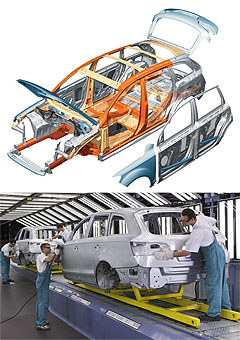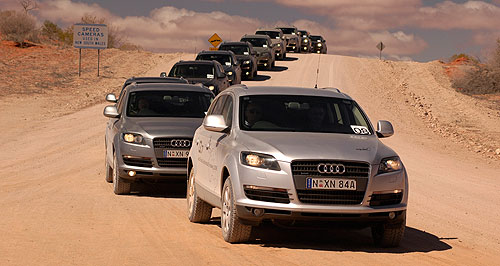Make / Model Search
News - AudiAudi to halt vehicle size increasesBig enough: The next-generation Q7 will be smaller than the current car. Audi to stunt growth of its vehicles to save fuel and cut emissions14 Sep 2009 By JAMES STANFORD in FRANKFURT AUDI has vowed to stop increasing the size of its cars in a bid to keep weight under control. As the car industry wrestles with the problem of providing customers with the comfort and safety they require while also meeting strict new fuel economy and emission controls, Audi has made the decision to stop increasing the size of its cars. For decades, Audi, as well as most mainstream car-makers, has constantly increased the size of its vehicles with each new model introduction. Total vehicle development leader Martin Weisbrodt, based at Audi’s Lightweight Design Centre at Neckarsulm, told GoAuto that this practice had contributed to a weight increase spiral and had to stop. “We will not continue doing this,” he said. “Our cars will not continue to increase.” Mr Weisbrodt said the next Q7 all-wheel-drive was an indication of its future policy. “The new Q7 will not be larger,” he said. “In fact, it will actually be a little bit smaller.”  Left: Audi Q7 construction, with extensive use of light-weight materials. Left: Audi Q7 construction, with extensive use of light-weight materials.While he said the process of making cars larger had worked in the past, it was now out of line with customer demand. “We are finding that due to cost effectiveness, many people are buying smaller cars,” he said. “If we continue to make our cars larger and larger, people will not buy them.” Audi points out that the weight saved by limiting vehicle size and using a range of lightweight components will have a big effect of fuel consumption, as well as making the cars fun to drive. It said that cutting a vehicle’s weight by 100kg reduced fuel consumption by between 0.3 litres per 100km and 0.5L/100km. Audi has long been at the forefront of lightweight design and has now produced 550,000 cars with aluminium bodies, but has been ramping up its efforts to cut weight from vehicles as fuel consumption and reduced emissions become increasingly more important. Producing aluminum generates much more emissions than steel, thanks to the large amounts of electricity required, a fact that Audi doesn’t doubt. It argues that the emissions linked to aluminium are limited if the electricity is generated from renewable sources. Audi claims using significant amounts of aluminium is still a better option for the environment, when the electricity is generated by traditional methods, because of the savings that come when the vehicle is in use. “Because of the weight savings, the vehicle is using less fuel,” Mr Weisbrodt said. “We estimate that the break-even point in terms of energy use for the aluminium comes at around the halfway point of its life – anywhere from 20,000 to 50,000km.” Apart from keeping the size of its vehicles in check, Audi is looking at using new materials to shed weight. It already uses 11 different grades of steel on some models, for the optimum strength and minimum weight, but is now looking at increasing the amount aluminium, magnesium, plastics and carbon fibre-reinforced plastics. Magnesium, one third lighter than aluminium, has long been used for select components in premium cars and more widely on motorcycles, but Audi, along with other car-makers, are using more of it and has even used die-cast magnesium for the engine frame of the new R8 supercar. Audi says it will soon introduce more magnesium engine components for its V6 engines, while a large transmission crossmember for the new A8 also will be magnesium. Audi displayed prototype components made of carbon-fibre reinforced plastics that might soon replace aluminium components in its cars. One example was a transverse suspension link which weighs 860gm when made from steel sheet, but tips the scales at 440gm when made from the fibre composite. Audi is looking at all parts of the car and assembly processes in the bid to shave kilos. For example, most car-makers stick heated bitumen mats to the floor of the car for sound insulation. Audi has moved away from this process and now sprays the floor with an acrylic substance used to seal joints in house construction. It says this material is 25 per cent lighter, saving 12kg per vehicle, and is also better at suppressing noise. Audi said the arrival of new hybrid and electric vehicles would make weight reduction even more important. “Batteries are very heavy,” Mr Weisbrodt said. “At this stage the weight of batteries is an Achilles heel.” Mr Weisbrodt said Audi’s lightweight component expertise would give the company an advantage when it came to keeping the weight of electric vehicles in check, in spite of heavy batteries. “All the weight you can save is important. A weight saving of 100kg would extend the cruising range of an electric vehicle by 7.7 per cent,” he said.  Read more |
Click to shareAudi articlesResearch Audi Motor industry news |










Facebook Twitter Instagram